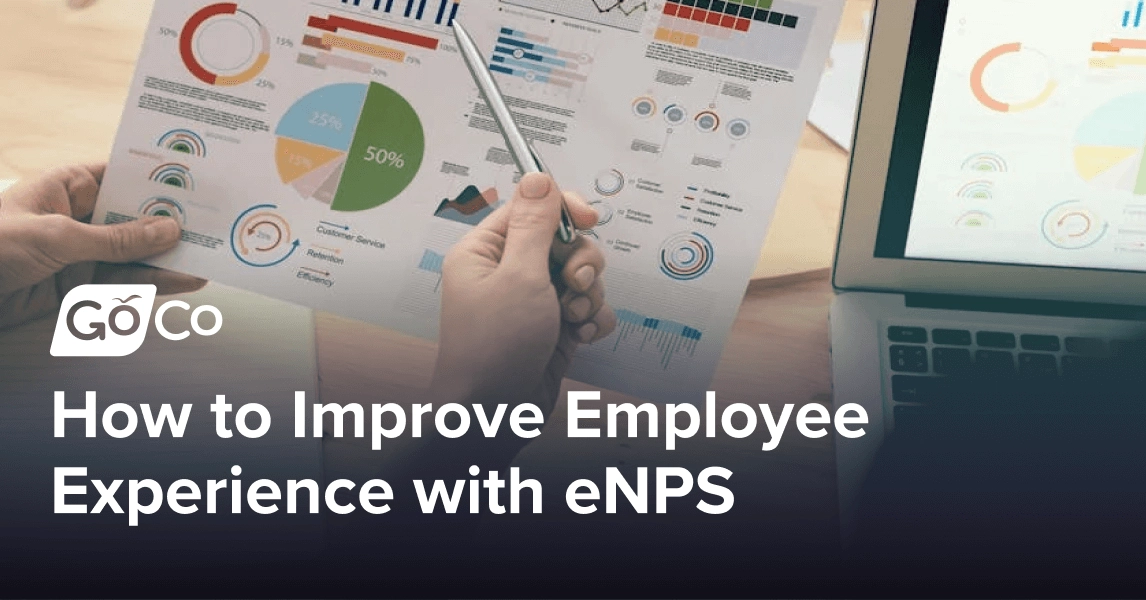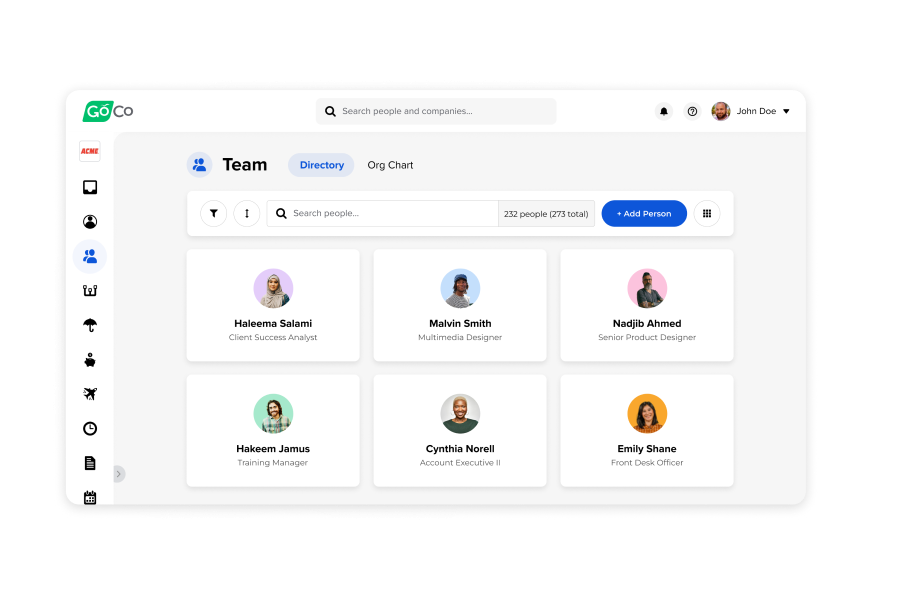How to Improve Employee Experience with eNPS [+template]
Discover how to calculate and benchmark your company's employee net promoter score to improve your employee strategy around engagement and retention.
by Rachel McQuigge - June 5th, 2024
Employee experience matters more than ever in today's competitive job market, where retaining talented employees is becoming increasingly challenging. Employees who feel supported by their company take on tasks and responsibilities that improve the business, while those who don't feel apathetic at best.
How can we make sense of the nebulous idea of employee experience? Do you know where your employees stand? If not, calculating the Employee Net Promoter Score is a great place to start. This article will serve as a resource for HR on using eNPS (Net Promoter Score) to improve employee strategy, retention, and loyalty. Let's start with some definitions to get everyone on the same page.
Download Our FREE eNPS Survey Template
Employee Experience vs. Employee Engagement
Employee Experience captures the entirety of the relationship between employees and an organization, as well as what people encounter and observe throughout their tenure.
Employee Engagement measures the degree to which employees invest their mental, emotional, and behavioral energies toward positive organizational outcomes.
So, what exactly is the difference? Employee experience is the overarching concept of an employee's experience in a workplace, whereas employee engagement directly informs whether people are willing to invest in this experience. It answers how ready employees are to invest their time, energy, and intellect in any organization.
Why Does Employee Experience Matter?
In short, a positive employee experience helps with recruiting, retention, and the bottom line. There is also a consistent correlation between employee experience and customer experience.
Recruiting: Resources like GlassDoor are increasingly popular, and bad reviews may scare potential employees away.
Retention: Around 31% of employees have quit a job within six months of starting. A good onboarding experience is critical. Training is often resource-intensive, expensive, and time-consuming.
Bottom line: When organizations get employee experience right, they can achieve twice the customer satisfaction and innovation and generate 25% higher profits than those that don't.
How Do You Measure Employee Experience?
The easiest way is through employee engagement surveys. However, this quickly becomes a long answer. There are many theories on which questions to ask, how many, and how often. Then, there is the process of deciding what to do with the data once it's gathered. Things get muddied quickly.
Through obscurity, eNPS rises to the top. One question (or two) offers an efficient and effective measure of employee engagement.
What is Employee Net Promoter Score (eNPS)?
Employee Net Promoter Score (eNPS) is a scoring system designed to help employers measure employee satisfaction and loyalty within their organizations.
Some hesitations around eNPS are about its simplicity and how it may need to be more accurate when used in smaller organizations. These hesitations highlight the importance of consistency in measuring and tracking comes in. Setting personal benchmarks and using them to gauge reactions to changes within your organization is critical for smaller organizations.
The strength of eNPS is its simplicity. Often, employee satisfaction surveys' results become cluttered with data. eNPS gives you one actionable data point, which makes it quick and efficient to analyze and address.
How Often Should You Measure eNPS?
Ideally, eNPS is measured monthly. This may seem too frequent at first glance, but the key is to ask only one question (or two) once per month via a pulse survey. This makes it low-effort enough for employees to be more willing to respond and frequent enough to capture changes and adjust as needed. How do your employees react to new HR policies, meetings, or announcements?
Measuring eNPS quarterly or yearly makes determining why scores increase or decrease more challenging.
However, as a company, you must self-reflect. Can you analyze and react to the data frequently enough? How likely are your recipients to respond? If there is not enough bandwidth to commit to gathering and reacting to this data monthly, a less frequent timeline may be a better fit for your organization.
How to Measure eNPS
Ask your employees two questions. Question 1: How likely would they recommend the organization as a workplace? (0-10) Question 2: Why did they give the score they did?

Promoter = Score 9-10
Promoters are highly satisfied and likely recommend your organization as a workplace.
Passive/Neutral = Score 7-8
Passives are employees who are satisfied enough to be content but may only be partially engaged.
Detractors = Score 6 or below
Detractors are unlikely to recommend their organization, which may indicate employee dissatisfaction.
(# of Promoters - # of Detractors) / # of Respondents = eNPS
An eNPS score can range from +100 (all promoters) to -100 (all detractors). An industry benchmark is that between 0 and 30 is a good eNPS. Anything above 30 is great. Anything below 0 indicates room for improvement.
An effective eNPS survey will take steps to ensure anonymity among its respondents to guarantee honest feedback. It could be more efficient to gather artificially inflated results.
If your organization finds this an effective strategy, including an optional question asking how your company could increase the score may provide insights on improving employee engagement levels. Another approach is to use eNPS in conjunction with sentiment analysis (or mood tracking). The mood analysis can provide a better understanding of how employees are feeling.
What is a Good eNPS Score?
A rule of thumb is that an eNPS score between 10 and 30 is considered good, and anything above 30 is excellent. The most important thing is to benchmark your company's eNPS against historical scores and industry averages, if available.
According to the global benchmark data of more than 150,000 organizations surveyed by SurveyMonkey, the average for NPS (not eNPS) is 32, but this also varies across industries. A report created by relationwise indicates that the Top 10 companies for eNPS ranged from first place Hubspot, with an eNPS of 92, to Intuit in tenth place, with an eNPS of 59.
Tools for Measuring eNPS
A wealth of tools exist for measuring eNPS. If you feel crafty, a DIY version using Google Forms or Survey Monkey will work. However, someone in your organization must remember to send the survey and also collect and analyze the data monthly. It can be time-consuming.
GoCo can help with building employee engagement and loyalty efforts!
Feedback Timelines – With GoCo's Performance Management feature, each employee has a timeline where you can post notes, praises and improvements, employment changes, and performance documents. It's an excellent way for employees to stay connected and on top of their goals and performance. Employees and managers can take private or shared notes depending on their preferences. This is an excellent supplement to the eNPS score because it consistently tracks how your employees feel and their goals within 1:1s and meetings.
Anonymous Workflows – Another great supplement to the eNPS tracking is GoCo's new anonymous workflows feature. With this feature, employees can submit an anonymous workflow, which removes any pressure or uncertainty an employee has about submitting potentially sensitive or negative information. Employees can provide suggestions for business improvement, report sexual harassment, and more – all while remaining anonymous. This is a good way for organizations and HR to find ways to improve, continuously take feedback, and build a positive culture.
Ready to see how GoCo can simplify your employee engagement and performance efforts? Take a free tour of our platform today!
FAQs
-
Employee experience captures the entirety of the relationship between employees and an organization, as well as what people encounter and observe throughout their tenure.
Employee engagement measures the degree to which employees invest their mental, emotional, and behavioral energies toward positive organizational outcomes.
-
Employee Net Promoter Score (eNPS) is a scoring system designed to help employers measure employee satisfaction and loyalty within their organizations.
-
Ideally, eNPS is measured monthly via short pulse surveys that are one or two questions long.
-
A rule of thumb is that an eNPS score between 10 and 30 is considered good, and anything above 30 is excellent.
Updated 6/5/2024

Subscribe to Beyond The Desk to get insights, important dates, and a healthy dose of HR fun straight to your inbox.
Subscribe hereRecommended Posts
22 Employee Engagement Ideas That Remote Workers Love
Blog Articles
35+ Employee Engagement Survey Questions You Must Ask
Blog Articles
Search...
Product
GoCo
Resources
Articles
eBooks
Webinars
Customer Stories









